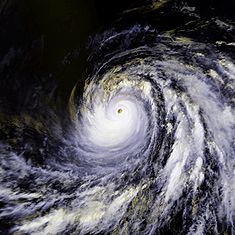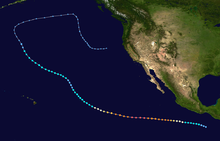Hurricane Guillermo (1997)
| Category 5 hurricane ( SSHWS ) | ||
|---|---|---|
| Hurricane Guillermo on August 5, 1997 | ||
| Emergence | 30th July | |
| resolution | 15th of August | |
|
Peak wind speed |
|
|
| Lowest air pressure | 919 mbar ( hPa ; 27.2 inHg ) | |
| dead | 3 direct | |
| Property damage | Unknown | |
|
Affected areas |
Pacific coast of Mexico , California , Hawaii | |
| Season overview: 1997 Pacific hurricane season |
||
Hurricane Guillermo was the seventh storm of the very active Pacific hurricane season in 1997 . It formed as a tropical wave off the coast of Africa on July 16 and reached the Pacific 11 days later. Guillermo was absorbed into an extratropical depression on August 24th, one month after its formation in the Atlantic. Except for increased swell and surf on the coast of California , Guillermo had no impact on the mainland. Three people were killed directly by Guillermo.
Guillermo was the twelfth hurricane to reach category five on the Saffir-Simpson hurricane wind scale in the Eastern Pacific Basin . The lowest air pressure was 919 mbar, making it the second strongest hurricane in the history of the weather records in this area at the time.
Storm course
Radio probe data from Dakar showed that a tropical wave had formed off the coast of Africa on July 16. This wave moved westward with little change in convection from strong westerly winds. Projections showed that the wave would arrive in a cloudy area on the Pacific coast of Mexico on July 27th. The convection intensified and the wave intensified on July 30 to tropical low 10-E, 555 km south of Salina Cruz , Mexico. This low quickly gained strength over the Pacific Ocean and became Tropical Storm Guillermo the next day. After cloud circulation began and the storm continued to gain strength, it turned into a hurricane on August 1st near Acapulco . After the discharge developed well at altitude, the hurricane formed an eye and Guillermo intensified into a Category 2 hurricane at 12:00 UTC on August 2. Six hours later it reached Category 3 and another six hours later it was a Category 4 hurricane.
As the hurricane moved across the eastern Pacific, it varied in strength. On August 5th, Guillermo achieved category 5 status with wind speeds of 260 km / h and a minimum air pressure of 919 mbar, making it one of the strongest storms in the Eastern Pacific.
As quickly as Guillermo intensified, so quickly did he lose strength. Shortly before it reached the Central Pacific, it was only as strong as a tropical storm on August 10th. It began to weaken only a short time later and was downgraded to a tropical storm on August 10, just before it reached the Central Pacific Basin. After crossing the 140th degree of western longitude, the Central Pacific Hurricane Center took over monitoring of the storm. Guillermo continued to weaken to a tropical low, but regained the strength of a tropical storm shortly thereafter. In the vicinity of the Hawaiian Islands it temporarily moved west-northwest and weakened again on August 15 to a tropical depression. On August 16, Guillermo became an extra-tropical cyclone and turned on an east-northeast orbit. He pulled parallel to the coast of Alaska, keeping a distance of about 800 km. On August 19, about 925 km off the coast of British Columbia , he turned south. Guillermo was finally absorbed into an extra-tropical depression off the coast of California on August 24th .
Effects
| Surname | season |
|---|---|
| Patsy | 1959 |
| "Mexico" | 1959 |
| Ava | 1973 |
| Emilia | 1994 |
| Gilma | 1994 |
| John | 1994 |
| Guillermo | 1997 |
| Linda | 1997 |
| Elida | 2002 |
| Hernan | 2002 |
| Kenna | 2002 |
| Ioke | 2006 |
| Rick | 2009 |
| Celia | 2010 |
| Patricia | 2015 |
Guillermo caused high surf on the coast of Southern California and Lower California . This reached an average of 1.8–2.4 m, locally more than 3 m. The waves caused by Guillermo hit the beaches of Orange County with a wave height of 1.8-3.6 m. Hundreds of people had to be rescued from the water and the pull of the waves left three injured and one dead. On August 5, a 19-year-old man was washed away on Huntington Beach Pier and his body was not found until a few days later. On August 6, two teenagers were injured on Corona del Mar beach and another was rushed to hospital with a neck injury. On August 5th and 6th alone, lifeguards completed nearly 300 missions in Newport Beach . The waves in Hawaii peaked between August 15 and 17. They caused no property damage and were up to 3 m high on the eastern shoreline.
At the time, Guillermo's minimum central air pressure of 919 mbar (919 hPa) was the second strongest Pacific hurricane since records began, only Hurricane Ava was stronger. Later in the season, Hurricane Linda set a new record, and in later years Hurricanes Kenna and Ioke both hit lower air pressures than Guillermo. But Guillermo is the strongest Pacific hurricane that formed in August. Its duration of 16.5 days is the sixth longest observed in the eastern and central Pacific Oceans.
The name Guillermo was not removed from the list of tropical cyclone names and was used again during the 2003 season . He's on the list for the 2009 season .
Web links
- NHC 1997 Pacific hurricane season archive (English)
- HPC 1997 Tropical Cyclone Rainfall (English)
- Central Pacific Hurricane Center (English)
Individual evidence
- ↑ a b c d e B. Max Mayfield: Hurricane Guillermo Preliminary Report . National Hurricane Center. 1997. Retrieved March 6, 2007.
- ^ A b National Hurricane Center: Hurricane Guillermo Preliminary Report ( English ) Central Pacific Hurricane Center. 1997. Retrieved November 23, 2008.
- ^ NCDC: Event- Heavy Surf- Aug 06, 1997, 6:00:00 AM PST ( English ) NOAA. 1997. Archived from the original on September 7, 2009. Info: The archive link was automatically inserted and not yet checked. Please check the original and archive link according to the instructions and then remove this notice. Retrieved March 6, 2007.
- ^ NCDC: Event- Rip Currents- Aug 05, 1997, 6:00:00 AM PST ( English ) NOAA. 1997. Archived from the original on July 6, 2010. Info: The archive link was automatically inserted and not yet checked. Please check the original and archive link according to the instructions and then remove this notice. Retrieved March 6, 2007.
- ↑ National Hurricane Center: Eastern Pacific hurricane best track analysis 1949-2014 ( English ) United States National Oceanic and Atmospheric Administration's Office of Oceanic & Atmospheric Research. October 15, 2015. Retrieved October 25, 2015.
- ↑ Fact Sheet Tropical Cyclone Names ( English , PDF; 291 kB) World Meteorological Organization . S. January 4th. Retrieved May 22, 2008.


